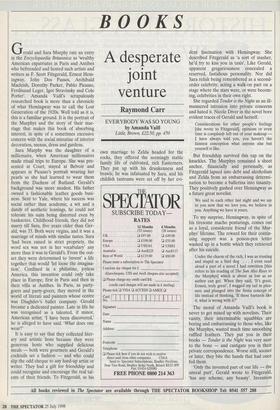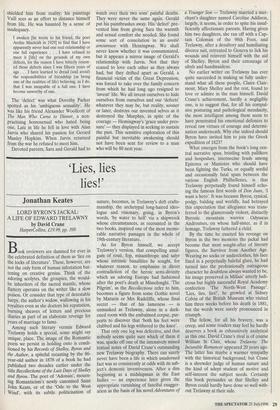BOOKS
A desperate joint venture
Raymond Carr
EVERYBODY WAS SO YOUNG by Amanda Vaill Little, Brown, £22.50, pp. 470 Gerald and Sara Murphy rate an entry in the Encyclopaedia Britannica as 'wealthy American expatriates in Paris and Antibes who befriended and hosted such artists and writers as F. Scott Fitzgerald, Ernest Hem- ingway, John Dos Passos, Archibald Macleish, Dorothy Parker, Pablo Picasso, Ferdinand Leger, Igor Stravinsky and Cole Porter'. Amanda Vaill's scrupulously researched book is more than a chronicle of what Hemingway was to call the Lost Generation of the 1920s. Well told as it is, this is a familiar ground. It is the portrait of the Murphys and the story of their mar- riage that makes this book of absorbing interest, in spite of a sometimes excessive concern with the social minutiae of interior decoration, menus, dress and gardens.
Sara Murphy was the daughter of a millionaire, when American millionaires made ritual trips to Europe. She was pre- sented at Court, stayed at Belvoir and appears in Picasso's portrait wearing her pearls as she had learned to wear them from the Duchess of Rutland. Gerald's background was more modest. His father owned a fashionable leather goods busi- , ness. Sent to Yale, where his success was social rather than academic, a wit and a dandy of aesthetic leanings, he could not tolerate his suits being distorted even by banknotes. Childhood friends, they did not marry till Sara, five years older than Ger- ald, was 33. Both were virgins, and it was a marriage of minds with similar tastes. Sara tad been raised in strict propriety, the word sex was not in her vocabulary' any more than it was in Gerald's. From the out- set they were determined to `invent' a life together that would 'let loose the imagina- tion'. Confined in a philistine, joyless America, this invention could only take place in Europe, first in Paris and then in their villa at Antibes. In Paris, as party- goers and party-givers, they moved in the world of literati and painters whose centre was Diaghilev's ballet company. Gerald became a dedicated painter. Late in life he was recognised as a talented, if minor, American artist; 'I have been discovered,' he is alleged to have said. 'What does one wear?'
It is easy to say that they collected liter- ary and artistic lions because they were generous hosts who supplied delicious meals — both were gourmets and Gerald's cocktails set a fashion — and who could slip the odd cheque to any hard-up artist or writer. They had a gift for friendship and could recognise and encourage the real tal- ents of their friends. To Fitzgerald, as his own marriage to Zelda headed for the rocks, they offered the seemingly stable family life of cultivated, rich Easterners. They put up with his drunkenness and brawls; he was infatuated by Sara, and his childish tantrums were set off by her evi- dent fascination with Hemingway. She described Fitzgerald as `a sort of masher, he'd try to kiss you in taxis'. Like Gerald, apparent gregariousness concealed a reserved, fastidious personality. Nor did Sara relish being remembered as a second- order celebrity, acting a walk-on part on a stage where the stars were, or were becom- ing, celebrities in their own right.
She regarded Tender is the Night as an ill- mannered intrusion into private concerns and hated it. Nicole Diver in the novel bore evident traces of Gerald and herself.
Considerations for other people's feelings [she wrote to Fitzgerald], opinions or even time is completely left out of your makeup — I have always told you, you haven't the faintest conception what anyone else but yourself is like.
But friendship survived this rap on the knuckles. The Murphys remained a sheet anchor, financially and personally, as Fitzgerald lapsed into debt and alcoholism and Zelda from an embarrassing determi- nation to become a ballerina into insanity. They positively gushed over Hemingway as a future great novelist.
We said to each other last night and we say to you now that we love you, we believe in you. Anything we have is yours.
To my surprise, Hemingway, in spite of his tiresome macho posturings, comes out as a loyal, considerate friend of the Mur- phys' lifetime. The reward for their contin- uing support was a poison-pen letter washed up in a bottle which they retrieved after his suicide.
Under the charm of the rich, I was as trusting and stupid as a bird dog . . . I even read aloud a part of a novel I had rewritten [this refers to his reading of The Sun Also Rises to the Murphys] which is about as low as an author can get. When they said, 'It's great, Ernest, truly great', I wagged my tail in plea- sure and plunged into the fiesta concept of life instead of thinking, 'If these bastards like it, what is wrong with it?'
The moral of Amanda Vaill's book is never to get mixed up with novelists. Their vanity, their interminable squabbles are boring and embarrassing to those who, like the Murphys, wasted much time smoothing ruffled feathers. They put you in their books — Tender is the Night was very near to the bone — and castigate you in their private correspondence. Worse still, sooner or later, they bite the hands that had once fed them.
'Only the invented part of our life — the unreal part', Gerald wrote to Fitzgerald, 'has any scheme, any beauty'. Invention shielded him from reality; his paintings Vail sees as an effort to distance himself from life. He was haunted by a sense of inadequacy.
I awaken [he wrote to his friend, the poet Archie Macleish in 1929] to find that I have apparently never had one real relationship or one full experience . . . I have refused to meet it [life] on the grounds of my own defects, for the reason I have bitterly resent- ed those defects since I was fifteen years of age . . . I have learned to dread (and avoid) the responsibilities of friendship (as being one of the realities of life) believing, as I do, that I was incapable of a full one. I have become unworthy of one.
The 'defect' was what Dorothy Parker spotted as his 'ambiguous sexuality'. He was like his friend Alexander Woollcott of The Man Who Came to Dinner, a non- practising homosexual who hated being one. Late in life he fell in love with Alan Jarvis who shared his passion for Gerard Manley Hopkins. When Jarvis returned from the war he refused to meet him.
Devoted parents, Sara and Gerald had to watch over their two sons' painful deaths. They were never the same again. Gerald put his paintbrushes away. His 'defect' pre- vented him from giving Sara the warmth and sexual comfort she needed. She found some sort of consolation in an amitie amoureuse with Hemingway. We shall never know whether it was consummated, but it appears a mirror image of Gerald's relationship with Jarvis. Not that they ceased to love each other as they always had, but they drifted apart as Gerald, a financial victim of the Great Depression, was forced to take over the family concern from which he had long ago resigned to 'invent' life. We all invent ourselves to hide ourselves from ourselves and our 'defects' whatever they may be, but reality, sooner or later, destroys our invented selves as it destroyed the Murphys, in spite of the courage — Hemingway's 'grace under pres- sure' — they displayed in seeking to sustain the past. This sensitive exploration of this painful but inevitable awakening should not have been sent for review to a man who will be 80 next year.



























































 Previous page
Previous page